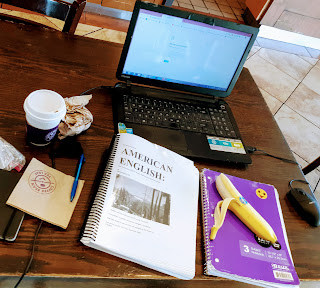Learn proper pronunciation. Study the complete American English sound system; vowels, consonants, words, and sentence construction. Then read dialogues and speeches reviewing vocabulary for Kitchens, Bedrooms, Bathrooms, Business English, Internet terms, Clichés, Anatomy, Nursery, and Citizenship.
Search This Blog
Saturday, February 16, 2019
Saturday, February 2, 2019
Understanding American Football: Get ready for the Superbowl
4.21 American Football
Exercise 1: Repeat the phrases and definitions aloud.
The idea is to carry the football across the end zone to score a touchdown. Each team gets four tries to advance 10 yards. If they move the ten yards, then it’s considered a first down, and they get four more attempts.
A touchdown is worth 6 points, and a field goal is worth 3 points, a try is for an extra 1 or 2 points. A safety is worth 2 points.
Positions: 11 players each team. There is an offensive and a different defensive team. The field is 50 yards long on each side.
Offensive team
Quarterback: The Quarterback calls the plays during the huddle, shouts the signals at scrimmage and receives the ball from the snap.
Halfback: The halfback blocks and carries the ball on running plays.
Fullback: Fullbacks are usually larger than halfbacks and function as blockers.
Center: The Center is the leader of the offensive line, who handles the football on every play. On either side of the center are the guards, while tackles line up outside the guards.
Guard: A guard is a blocker whose job it is to protect the Quarterback.
Tackle (tak-uhl): The tackles are the outside two members of the offensive line. A tackle occurs when a player carrying the ball is knocked to the ground by an opposing team member and the play is then considered over.
Tight end: The tight end is both a receiver and a blocker.
Wide receiver (ri-see-ver): The wide receiver is usually the quickest on the offensive team.
Defense (dih-fens) team:
Defensive Line: The defensive line is used to prevent a running play as well as to block passing to receivers. The line has 3-5 players usually including:
Cornerbacks: Cornerbacks are the wide guards of the field and are opposite offensive receivers. Cornerbacks cover receivers and runners that get missed by the line.
Defensive Tackles: The defensive tackles are inside the defensive line.
Nose Guard: The nose guard is a defensive lineman who is the largest and strongest player who can stop action in the center of scrimmage.
Defensive Ends: The defensive ends job is to sack the quarterback.
Linebackers: Linebackers are the main line of defense and are usually fast and excellent blockers.
Cornerbacks:
Safety: The Safety is the last resort defense.
Special teams: Special teams is the name given to the punter, field goal kicker, place holder, and snapper.
Punter: The punter is a player who can kick punts while moving and during the game. He can usually place the football with great accuracy anywhere on the field.
Fumble: When a team member drops or loses the football.
A safety is when a player allows the ball to go into his end zone.
CALL/TEXT/EMAIL FOR AMERICAN ENGLISH TUTORING //mrubman@gmail.com
A touchdown is worth 6 points, and a field goal is worth 3 points, a try is for an extra 1 or 2 points. A safety is worth 2 points.
Positions: 11 players each team. There is an offensive and a different defensive team. The field is 50 yards long on each side.
Offensive team
Quarterback: The Quarterback calls the plays during the huddle, shouts the signals at scrimmage and receives the ball from the snap.
Halfback: The halfback blocks and carries the ball on running plays.
Fullback: Fullbacks are usually larger than halfbacks and function as blockers.
Center: The Center is the leader of the offensive line, who handles the football on every play. On either side of the center are the guards, while tackles line up outside the guards.
Guard: A guard is a blocker whose job it is to protect the Quarterback.
Tackle (tak-uhl): The tackles are the outside two members of the offensive line. A tackle occurs when a player carrying the ball is knocked to the ground by an opposing team member and the play is then considered over.
Tight end: The tight end is both a receiver and a blocker.
Wide receiver (ri-see-ver): The wide receiver is usually the quickest on the offensive team.
Defense (dih-fens) team:
Defensive Line: The defensive line is used to prevent a running play as well as to block passing to receivers. The line has 3-5 players usually including:
Cornerbacks: Cornerbacks are the wide guards of the field and are opposite offensive receivers. Cornerbacks cover receivers and runners that get missed by the line.
Defensive Tackles: The defensive tackles are inside the defensive line.
Nose Guard: The nose guard is a defensive lineman who is the largest and strongest player who can stop action in the center of scrimmage.
Defensive Ends: The defensive ends job is to sack the quarterback.
Linebackers: Linebackers are the main line of defense and are usually fast and excellent blockers.
Cornerbacks:
Safety: The Safety is the last resort defense.
Special teams: Special teams is the name given to the punter, field goal kicker, place holder, and snapper.
Punter: The punter is a player who can kick punts while moving and during the game. He can usually place the football with great accuracy anywhere on the field.
Fumble: When a team member drops or loses the football.
A safety is when a player allows the ball to go into his end zone.
CALL/TEXT/EMAIL FOR AMERICAN ENGLISH TUTORING //mrubman@gmail.com
Subscribe to:
Comments (Atom)









